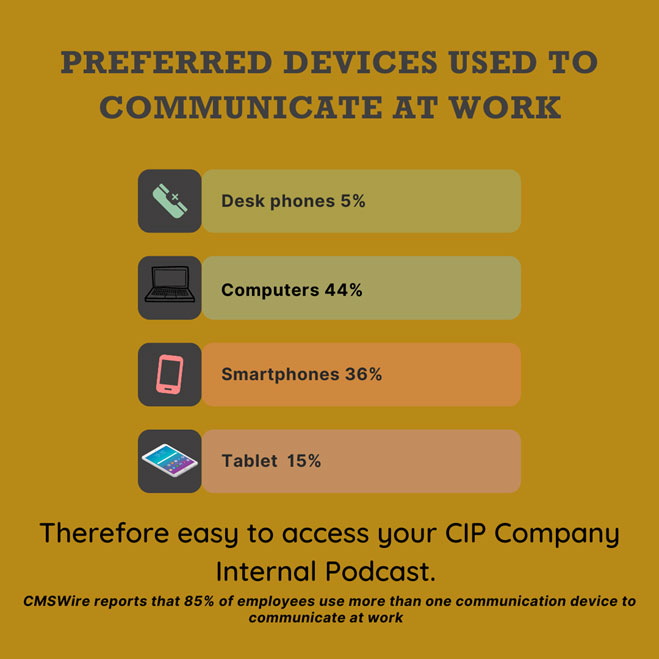Did you know an average employee receives around 100 emails per day according to the small business blog? That’s a lot of emails to check.
Most employees would agree that sifting through and replying to emails takes up way too much of their time and takes valuable time away from real productivity.
If employees are feeling overwhelmed by their inbox (67% according to inbox stats) It is surely worth taking a step back to really assess the way you communicate internally, and to consider adding a podcast, opposed to adding to the already busy inboxes?
Are numerous emails/newsletters the best way to happy, engaged teams?
Is it time to shake up your internal comms with a dedicated podcast?
This is something I am really passionate about and something I think could, and should, be in every organisation by the end of the decade. As we’ve said already your teams have email fatigue and want something more authentic and engaging from their employees.
Forward thinking organisations (especially in the US) are already using this inclusive method of internal communication – THE COMPANY INTERNAL PODCAST!
We know that business podcasts are on the up and that more and more SME’s are realising the benefits of having their own podcast. We already know how podcasts help to grow brands and boosts digital marketing but what about those podcasts that aren’t published to all and are in fact made for their own internal use?
This is where a CIP – Company Internal Podcast comes in!
If you answer YES to any of these questions your organisation could benefit from a CIP (Company Internal Podcast)
- Is the information you need your employees to hear not getting through?
- Are your teams overwhelmed with irrelevant information?
- Are you teams ignoring emails and company newsletters because it’s just more words on a page and clogging up of inboxes?
- Do you struggle to successfully communicate your companies’ key messages to employees and other stakeholders?
- Is it hard for you to deliver a consistent message to everyone in the company, keeping it inclusive and equitable for onsite and remote workers and on the road sales teams?
- Is the same message delivered in different forms for choice and equality?
- Are you planning and writing content knowing it’s not going to be read?
And here’s why – the benefits!
- Your staff have access to a computer and/or a smart phone and anyone with this access can listen to a podcast (95% preferred method of communication allows a CIP to be listened too)
- Audio is intimate and delivered directly into the ears of the listener and therefore holds the employee’s attention.
- Podcasts can be listened to anywhere and at any time. Your team can listen on their commute to and from work, during a break, whilst working on something else (you can’t do that when watching a video or reading an email)
- It gives your team a break from their screen.
- Imagine saying – take an extra ten minutes at lunch time and enjoy this weeks CIP – it all helps the health and wellbeing at work!
- Podcasts form authentic connections & you can hear the real tone and warmth in someone’s voice.
- It builds connections and a sense of belonging enhancing the culture
- It offers choice
- Everyone gets the same message in the same tone.
Ways to use your Company Internal Podcast
- Communications of company news in the same tone to everyone – no one misses out.
- Inclusivity – those in the business, those working remotely, and on-the-road sales teams will get the same information in the same way despite not all being present at a meeting.
- Departmental news – heads of departments can share news.
- Product updates – aales teams can listen and up-skill en-route to appointments.
- Employee news – build a strong culture with shared information
- Team building – feature a “job role of the week” so everyone in the organisation is aware how all roles contribute to the team as a whole.
- Values – reinforces company values and values the team.
- Onboarding – A great way to make a new employee feel at home – let them listen to the latest episodes and create specific episodes for new members of staff that they can re-listen to at any time.
- Training – add training news or modules
- HR legislation/law/news updates
Great communication makes a good organisation great but poor communication can seriously affect your team, culture and productivity.
Accord study by the Economist Intelligence Unit further illustrates how poor workplace communication can hurt the success of a workplace.
- Failure to complete projects — in 44% of the cases,
- Low employee morale — in 31% of the cases,
- Missed performance goals — in 25% of the cases, and;
- Lost sales — in 18% of the cases.
CMSWire reports that 85% of employees use more than one communication device to communicate at work — as many as 32% use three or more devices because they value flexibility.
When it comes to the actual device use, people tend to communicate via:
- Computers — in 44% of the cases
- Smartphones — in 36% of the cases
- Tablets — in 15% of the cases
- Desktop phones — in 5% of the cases

Here are some useful links to articles on internal comms:
https://www.linkedin.com/pulse/internal-communications-message-really-getting-latest-mike/?trackingId=BQZkev8zTyu%2F%2BKe4YKzxHQ%3D%3D
https://www.unily.com/insights/blogs/why-internal-comms-needs-more-than-email-to-engage-employees
https://pumble.com/learn/communication/communication-statistics
